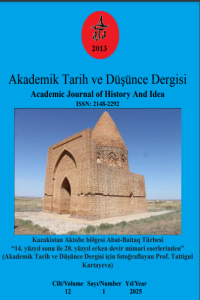Abstract
Çalışmanın konusu sarnıç, yuvarlak planlı olup, üzeri kubbe ile örtülüdür. Tek girişli kapı aksı ile yapı içerisine girilmekte olup, sarnıç haznesine inmeyi sağlayan merdiven, yapıda depolanan suyun yöre halkı tarafından teminini sağlamaktadır. Ayrıca merdiven; belli dönemlerde içerisinin temizlenmesi için hazneye ulaşımı rahatlıkla sağlaması açısından önemli bir mimari eleman olarak karşımıza çıkmaktadır. Su gözleri olarak nitelendirilen küçük boyutlu pencereler sayesinde sarnıca yağmur suları depolanmaktadır. Ayrıca bahsi geçen su gözleri, havalandırma ve aydınlatma görevi de görmektedir. Su gözleri, belli aralıklar ile iki sıra halinde (hazne duvarı ve kubbe kasnağının birleştiği noktalara ve kubbeye) sıralanmıştır. Bodrum yöresel mimarisinde sıkça karşımıza çıkan, moloz taşlarla yığma tekniğinde inşa yöntemi, çalışmanın konusu olan sarnıçta da görülmektedir. Bodrum’da inşa edilen birçok sarnıç, bahsi geçen üslup özelliklerini bünyelerinde barındırmaktadır. Osmanlı Dönemi’nde Bodrum’da inşa edilen, insanların su ihtiyacını uzun yıllar karşılayan, mimari ve sanat tarihi açasından önemli bir yere sahip olan sarnıçlar, işlevsel yapılar olarak karşımıza çıkmaktadır.
Keywords
References
- Bektaşoğlu M. (2013). Anadolu Şehrinin Su Yapıları. Aski Genel Müdürlüğü Yayınları.
- Bildirici M. (2009). Tarihi Su Yapıları. Çevre ve Orman Bakanlığı Devlet Su İşleri Genel Müdürlüğü Yayınları.
- Çamur, K. C. (2019). Suyumuzun Sürdürülebilir Yönetimi ve Kent Planlama İlişkisi Üzerinde Bodrum’un Geleceğine Yönelik Bir Değerlendirme. Bodrum Su Paneli, 68-80.
- Diler, A. (2007). Bodrum Kentsel Sit Halikarnassos Muğla Kültür Envanteri-I. Kültür ve Turizm Bakanlığı- Muğla Üniversitesi- Karya Araştırma ve Uygulama Merkezi.
- Diler, A. (2013). Bodrum Yarımadası Arkeolojik ve Sanat Tarihi Kalıntıları Muğla Kültür Envanteri III-1/III-2. Kültür ve Turizm Bakanlığı- Muğla Üniversitesi-Karya Araştırma ve Uygulama Merkezi.
- Elerman, O., Yazıcı, G. T., Gültekin, T. N. (2022). Su Yönetiminde Alternatif Su Kaynağı Sarnıçlar: Bodrum Yarımadasından Örnekler. Kent Araştırmaları Dergisi, 14, 510-533.
- Güngör, S. S. (2021). Osmanlı Su Mimarisi ve İstanbul’daki 19. Yüzyıl Su Yapıları. Türk Hidrolik Dergisi, 5 (1), 32-48.
- Kerim, A. & Süme, V. (2018). İstanbul’un Eski Su Kaynakları; Sarnıçlar. Türk Hidrolik Dergisi, 2 (2), 1-8.
- Öziş, Ü., Arısoy, Y., Alkan, A., & Özdemir, Y. (2008). Türkiye’deki Tarihi Su Yapılarının Evrensel Önemi. TMMOB 2. Su Politikaları Kongresi, 555-566.
- Ulaş A. (2023). Osmanlı Belgeleri Işığında İstanbul Yer Altı Yapıları. Vakıflar Genel Müdürlüğü Yayınları.
- Yaprak, N. (2009). Tarihi Kent Merkezlerindeki Su Yapılarının Koruma Problemleri İzmir Kemer Altı Örneği [Yayınlanmamış yüksek lisans tezi]. Dokuz Eylül Üniversitesi.
Abstract
The cistern subject of the study has a round plan and is covered with a dome. It is entered into the building with a single entrance door axis; and the staircase that allows descent to the cistern reservoir provides the water stored in the structure by the local people. In addition, the staircase is an important architectural element in terms of providing easy access to the cistern for cleaning in certain periods. Rainwater is stored in the cistern thanks to the small sized windows characterised as water holes. In addition, the aforementioned water eyes also serve as ventilation and lighting. The water eyes are arranged in two rows at certain intervals (at the points where the chamber wall and the dome pulley meet and on the dome). The method of construction with rubble stones in masonry technique, which is frequently encountered in Bodrum local architecture, is also seen in the cistern, which is the subject of the study. Many cisterns built in Bodrum have the aforementioned stylistic features. The cisterns built in Bodrum during the Ottoman Period, which met the water needs of the people for many years and have an important place in terms of architecture and art history, appear as functional structures.
Keywords
References
- Bektaşoğlu M. (2013). Anadolu Şehrinin Su Yapıları. Aski Genel Müdürlüğü Yayınları.
- Bildirici M. (2009). Tarihi Su Yapıları. Çevre ve Orman Bakanlığı Devlet Su İşleri Genel Müdürlüğü Yayınları.
- Çamur, K. C. (2019). Suyumuzun Sürdürülebilir Yönetimi ve Kent Planlama İlişkisi Üzerinde Bodrum’un Geleceğine Yönelik Bir Değerlendirme. Bodrum Su Paneli, 68-80.
- Diler, A. (2007). Bodrum Kentsel Sit Halikarnassos Muğla Kültür Envanteri-I. Kültür ve Turizm Bakanlığı- Muğla Üniversitesi- Karya Araştırma ve Uygulama Merkezi.
- Diler, A. (2013). Bodrum Yarımadası Arkeolojik ve Sanat Tarihi Kalıntıları Muğla Kültür Envanteri III-1/III-2. Kültür ve Turizm Bakanlığı- Muğla Üniversitesi-Karya Araştırma ve Uygulama Merkezi.
- Elerman, O., Yazıcı, G. T., Gültekin, T. N. (2022). Su Yönetiminde Alternatif Su Kaynağı Sarnıçlar: Bodrum Yarımadasından Örnekler. Kent Araştırmaları Dergisi, 14, 510-533.
- Güngör, S. S. (2021). Osmanlı Su Mimarisi ve İstanbul’daki 19. Yüzyıl Su Yapıları. Türk Hidrolik Dergisi, 5 (1), 32-48.
- Kerim, A. & Süme, V. (2018). İstanbul’un Eski Su Kaynakları; Sarnıçlar. Türk Hidrolik Dergisi, 2 (2), 1-8.
- Öziş, Ü., Arısoy, Y., Alkan, A., & Özdemir, Y. (2008). Türkiye’deki Tarihi Su Yapılarının Evrensel Önemi. TMMOB 2. Su Politikaları Kongresi, 555-566.
- Ulaş A. (2023). Osmanlı Belgeleri Işığında İstanbul Yer Altı Yapıları. Vakıflar Genel Müdürlüğü Yayınları.
- Yaprak, N. (2009). Tarihi Kent Merkezlerindeki Su Yapılarının Koruma Problemleri İzmir Kemer Altı Örneği [Yayınlanmamış yüksek lisans tezi]. Dokuz Eylül Üniversitesi.
Details
| Primary Language | Turkish |
|---|---|
| Subjects | Urban Design |
| Journal Section | Articles |
| Authors | |
| Early Pub Date | March 17, 2025 |
| Publication Date | April 8, 2025 |
| Submission Date | January 5, 2025 |
| Acceptance Date | March 17, 2025 |
| Published in Issue | Year 2025 Volume: 12 Issue: 1 |
По всем вопросам приема статей и выпуска очередных номеров обращаться в редакцию соответствующего журнала


